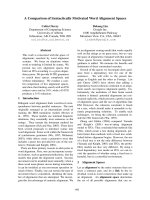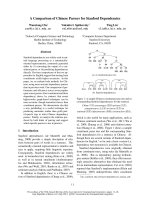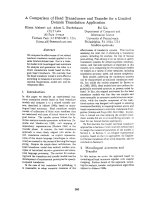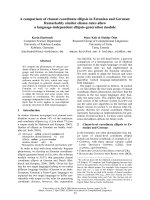Báo cáo sinh học: "A comparison of genetic data from New Zealand and France on twin calving in cattle" potx
Bạn đang xem bản rút gọn của tài liệu. Xem và tải ngay bản đầy đủ của tài liệu tại đây (319.07 KB, 6 trang )
Note
A
comparison
of
genetic
data
from
New
Zealand
and
France
on
twin
calving
in
cattle
CA
Morris
JL
Foulley
2
!
Ministry
of Agriculture
and
Fisheries,
Ruakura
Agricultural
Centre,
PB,
Hamilton,
New
Zealand
2
Institut
National
de
la
Recherche
Agronomique,
Station
de
G6n6tique
Quantitative
et
Appliquee,
Équipe
de
Genetique
Statistique,
78352
Jouy-en-Josas
Cedex,
France
(Received
21
March
1990;
accepted
3
June
1991)
Summary -
Data
on
twin
calvings
were
compared
from
New
Zealand
(1559
cows
in
3
selected
private
herds;
two
Milking
Shorthorn
and
one
Friesian)
and
France
(216
cows
in
11
Maine
Anjou
pedigree
herds).
Twin
calving
rates
(France
only)
and
cumulative
numbers
of
twin
calvings
per
lifetime
(both
countries)
were
obtained
for
all
cows,
classified
according
to
their
sire
and
dam
groups.
Dam
groups
were
defined
according
to
the
number
of
twin
calvings
in
the
dam’s
lifetime.
In
New
Zealand,
the
2
sire
groups
were
defined
as
follows :
(1)
no
daughter
producing
2
or
more
sets
of
twins;
(2)
at
least
one
such
daughter.
In
France,
the
discrimination
was
based
on
the
twin
calving
rate
of
daughters
recorded
in
the
whole
population
with
group
1
below
6%
and
group
2
over
that
value.
The
mean
frequencies
of
cows
with
at
least
one
set
of
twins
were
0.112
in
the
New
Zealand
herds
and
0.125
in
France.
In
both
countries,
there
were
significant
effects
of
sire
and
dam
groups,
but
no
interaction
on
a
logit
scale.
In
addition,
the
2
data
sets
showed
a
similar
increase
(x
1.9
to
x
2.5)
in
frequency
of
cows
producing
at
least
1
twin
set
comparing
those
from
dams
with
twins
and
those
from
dams
with
no
twin
set.
Resultats
demonstrated
the
opportunity
of
sire
selection
to
improve
twin
calving
performance.
The
efficiency
of
selection
would
also
be
enhanced
by
a
joint
choice
of
sires
dams
from
prolific
groups.
cattle
/
twinning
/
genetics
Résumé -
Une
comparaison
de
données
génétiques
françaises
et
néo-zélandaises
sur
le
taux
de
vêlages
gémellaires
des
bovins.
Cet
article
compare
des
données
de
vêlages
gémellaires
obtenues
en
Nouvelle-Zélande
(1559
vaches
de
.i
élevages
privés
dont
2
de
race
laitières
Shorthorn
et
1 de
race
Frisonne)
et
en
France
(216
vaches
provenant
de
11
élevages
de
sélection
de
race
Maine
Anjou).
On
disposait
du
taux
de
vêlages
gémellaires
(en
France
seulement)
et
du
nombre
cumulé
de
vêlages
gémellaires
dans
la
carrière
d’une
vache
et
de
leur
répartition
par
groupe
de
pères
et
de mères.
Les
groupes
de
mères
étaient
définis
selon
le
nombre
de
vêlages
gémellaires
observés
au
cours
de
la
carrière
de
la
vache.
*
Correspondence
and
reprints
En
Nouvelle-Zélande,
les
2 groupes
de
pères
étaient
définis
selon
que
le
père
comportait
(groupe 2)
ou
non
(groupe
1)
au
moins
une
fille
ayant
produit
au
moins
2 fois
des
jumeaux.
En
France,
la
discrimination
était
basée
sur
le
taux
de
vêlages
gémellaires
observés
sur
les
filles
contrôlées
dans
toute
la
population,
le
seuil
entre
les
deux
groupes
se
situant
à
6%.
La
fréquence
de
vaches
ayant
eu
au
moins
une
fois
des
jumeaux
était
de
0,112
en
Nouvelle-
Zélande
et
0,125
en
France.
Dans
les
2 pays,
on
a
mis
en
évidence
des
effets
significatifs
des
groupes
de
pères
et
de
mères,
mais
pas
d’interaction
sur
une
échelle
logit.
De
plus,
les
2
fichiers
indiquaient
des
accroissements
relatifs
similaires
des
performances
de
gémellité
entre
filles
issues
de
mères
n’ayant
eu
aucun
vêlage
gémellaire
et
celles
issues
de
mères
avec
au
moins
un
vêlage
gémellaire.
Ces
résultats
prouvent
l’intérêt
d’une
sélection
des
mâles
pour
améliorer
le
taux
de
vêlages
gémellaires
ainsi
que
celui
d’un
choix
simultané
de
parents
parmi
les
groupes
les
plus
prolifiques.
bovins
/
jumeaux
/
génétique
INTRODUCTION
Recent
studies
of
sire
and
dam
group
effects
on
twin
calving
in
New
Zealand
(NZ)
and
in
France
(F)
have
led
to
similar
findings
(Foulley
et
al,
1990;
Morris
and
Day,
1990).
Both
described
the
probability
of
obtaining
twin
calvings
from
daughters
of
different
sire
or
dam
groups.
This
was
in
spite
of
different
twin
calving
rates
per
year
in
the
2
studies
(0.031
and
0.077
in
NZ
and
F
respectively)
and
different
breed
composition
(Milking
Shorthorn
and
Friesian
in
NZ
vs
Maine
Anjou
in
F).
MATERIALS
AND
METHODS
Data
were
taken
from
the
2
studies
cited
above.
Briefly,
the
NZ
data
set
described
the
lifetime
incidence
of
twin
calvings
in
1559
cows
from
2
Milking
Shorthorn
herds
(calvings
1958-1987
and
1975-1987)
and
one
Friesian
herd
(calvings
1973-1987).
The
overall
twin
calving
rates
per
year
were
0.030,
0.031
and
0.033,
compared
with
a
national
average
for
dairy
herds
of
about
0.01
(New
Zealand
Dairy
Board,
1961).
There
was
a
cumulative
record
of
the
number
of
twin
calvings
per
lifetime
for
all
cows,
and
pedigree
available.
Apart
from
twin
calvings
each
year,
the
status
of
all
other
cows
(calved
or
non-pregnant)
was
not
recorded,
so
that
twin
calving
rates
on
individual
animals
were
not
known.
The
French
data
consisted
of
twin
calving
records
on
680
calvings
in
216
Maine
Anjou
cows
from
a
total
11
herds
involved
in
the
nucleus
of
the
high
twinning
selection
programme
set
up
in
that
breed.
In
both
data
sets,
cows
were
classified
according
to
sire
and
dam
groups
as
proposed
originally
by
Morris
and
Day
(1990).
In
New
Zealand,
sire
group
1
included
sires
with
no
daughters
producing
2
or
more
sets
of
twins
and
sire
group
2
included
those
with
at
least
1
such
daughter.
In
France,
the
classification
of
sires
was
based
on
the
twin
calving
rate
of
daughters
recorded
in
the
whole
population;
sire
below
6%
were
in
group
1
and
sires
over
that
value
were
in
group
2.
Dam
group
(i)
consisted
of
cows
from
dams
with
no
calvings
in
their
lifetime,
and
dam
group
(ii)
consisted
of
cows
from
dams
with
1
twin
calvings
or >
2
twin
calvings
in
their
lifetime.
The
categories
for
1
and
>
2
calvings
were
kept
separate
in
the
NZ
data,
but
were
combined
in
the
smaller
French
data
set.
Allowance
for
ascertainment
in
defining
sire
group
2
was
made
in
the
NZ
file
by
discarding
the
record
of
the
first
twice-twinning
daughter
used
to
classify
a
sire
as
group
2.
Within-country
analyses
of
effets
due
to
sire
and
dam
groups
were
reported
by
Morris
and
Day
(1990)
and
Foulley
et
al
(1990).
The
comparisons
made
here
were
effects
of
sire
groups
2
relative
to
sire
group
1,
and
of
dam
group
(ii)
relative
to
dam
group
(i)
for
both
countries.
The
traits
analysed
were
the
proportion
(t)
of
cows
producing
at
least
1
twin
set
in
a
lifetime
(NZ
and
F),
and
additionally
the
proportion
(v)
of
cows
producing
a
twin
set
per
calving
(French
data
only).
RESULTS
Table
I
shows
the
effects
of
sire
group
and
dam
group
on
the
proportion
t
for
both
countries
and
the
proportion
v
for
France.
The
value
v
(known
for
all
animals
in
the
NZ
data)
was
0.031
vs
0.077
for
France.
In
contrast,
mean
values
overall
for
t
were
similar :
0.112
for
NZ
(or
0.098
after
allowing
for
ascertainment)
and
0.125
for
F
data.
However,
this
similarity
is
mainly
due
to
a
balance
between
2
opposite
effects :
v
values
smaller
in
NZ
than
in
F
but
number
of
calvings
larger
in
NZ
than
in
F
(5
vs
3
on
average
respectively).
Differences
in
repeatability
between
countries
may
also
occur,
although
they
are
likely
to
be
small;
in
the
4
selected
private
herds
studied
by
Morris
and
Day
(1990),
only
18%
of
cows
with
a
twin
calving
had
a
second
or
latter
twin
set;
Foulley
et
al
(1990)
using
records
on
twinning
of
Charolais
and
Maine
Anjou
cows
prior
to
purchase
in
farms,
and
after
purchase
in
an
experimental
herd
found
a
realized
repeatability
of
0.05.
Significant
effects
of
sire
group
and
dam
on
t were
reported
by
Morris
and
Day
(1990).
The
same
conclusion
can
be
drawn
for
t
and
v from
the
statistical
analysis
made
with
French
data
using
a
logit
transformation
(see
table
II).
Table
III
shows
the
relative
increase
in
t
or
v
values
from
dam
groups
(i)
and
(ii)
and
from
sire
groups
1
and
2.
The
relative
increases
in
t
appeared
to
be
consistent
for
dams
groups
between
countries,
although
the
mean
twinning
rates
were
quite
different.
Overall,
the
relative
increases
in
t
were
1.9
and
2.5
between
dam
lifetime
twinning
groups
in
NZ
and
F
data,
respectively.
The
relative
increases
were
however
smaller
between
sire
groups
1
and
2
in
NZ
(average
1.8)
than
in
France
(average
6.2).
Although
breed
composition
and
environmental
factors
may
be
involved,
this
difference
mainly
reflects
the
difference
in
discriminating
the
2
groups
of
bulls
between
countries.
The
French
classification
of
sires
based
on
extra
field
records
(than
those
recorded
on
the
11
herds
studied)
results
in
a
larger
genetic
divergence
among
true
genetic
merits
of
bulls.
Actually,
the
effects
of
sire
and
dam
groups
on
v appear
to
be
purely
multiplicative
in
the
French
data
set :
dams
>
1/dams
0
=
2.5
irrespective
of
the
sire
group
and
sires
2/sires
1 =
5 irrespective
of
the
dam
group
(table
III).
DISCUSSION
The
absence
of
interaction
between
sire
and
dam
groups
found
in
both data
sets
(table
II)
legitimatizes
the
use
of
an
additive
model
to
describe
the
genetic
relationship
between
parents
and
progeny
on
a
logit
scale.
Because
the
cumulative
normal
and
the
logit
distribution
are
very
close,
this
result
supports
the
assumption
of
additive
genetic
determinism
on an
underlying
normal
liability
scale
as
postulated
by
several
authors
(Gregory
et
al,
1990;
Ron
et
al,
1990;
Manfredi
et
al;
1991).
Theoretically,
this
does
not
preclude
the
existence
of
a
major
gene
provided
its
effects
are
additive,
although
the
assumption
of
a
purely
additive
polygenic
model
would
be
just
as
relevant
in
such
a
case.
In
fact,
most
recent
studies
testing
for
the
presence
of
a
major
gene
segregating
for
twin
calving
rate
in
cattle,
ie
in
Norway
(Syrstad,
1984),
Israel
(Ron
et
al,
1990),
USA
(Gregory
et
al,
1990),
New
Zealand
(Morris
and
Day,
1990)
have
as
yet
been
unsuccessful.
Nevertheless,
the
important
increase
in
twinning
performance
due
to
using
group
2
vs
group
1
sires
(ranging
from
1.8-6.2)
highlights
the
opportunity
of
sire
selection
to
increase
twinning
performance
as
already
stressed
by
several
authors
eg
Johansson
et
al
(1974),
Maijala
and
Syv5jdrvi
(1977),
Gregory
et
al
(1990),
Ron
et
al
(1990),
and
Manfredi
et
al
(1990,
1991).
Moreover,
efficiency
of
selection
is
clearly
enhanced
by
a
joint
choice
of
sires
and
dams
as
shown
by
t and
v values
obtained
in
mating
group
2
sires
with
dams
having
at
least
one
set
of
twins.
Such
results
may
be
exploited
in
pratice
both
for
experimental
purpose
and
for
breeding
programmes.
ACKNOWLEDGMENTS
The
authors
wish
to
thank
the
New
Zealand
farmers
and
French
Maine
Anjou
breeders
whose
herds
are
involved
in
this
study.
They
are
also
grateful
to
M
Poutous
(INRA,
Jouy)
for
his
critical
reading
of
the
manuscript.
REFERENCES
Foulley
JL,
Gillard
P,
Manfredi
EJ
(1990)
Le
programme
de
Recherche
et
D6velop-
pement
de
l’INRA-Génétique
Animale
snr
la
Gemellite
(unpublished
mimeo)
Gregory
KE,
Echternkamp
SE,
Dickerson
GE,
CundifF LV,
Koch
RM,
Van
Vleck
LD
(1990)
Twinning
in
cattle :
I.
Foundation
animals
and
genetic
and
environmental
effects
on
twinning
rate.
J
Animal
Sci
68,
1867-1876
Johansson
I,
Lindhé
B,
Pirchner
F
(1974)
Causes
of
variation
in
the
frequency
of
monozygous
and
dizygous
twinning
in
various
breeds
of
cows.
Hereditas
78, 201-234
Maijala
K,
Syvajarvi
J
(1977)
On
the
possibility
of
developing
multiparous
cattle
by
selection.
Z
Tierziichtg
Ziichtgsbiol
94,
136-150
Manfredi
EJ,
San
Cristobal
M,
Foulley
JL,
Gillard
P,
Valais
A
(1990)
Genetic
analysis
of
twinning
in
the
Maine
Anjou
breed.
In :
41 th
Ann
Meet
EAAP,
Toulouse,
France,
July
9-12
1990,
vol
1,
114
abstr
Manfredi
EJ,
Foulley
JL,
San
Cristobal
M,
Gillard
P
(1991)
Genetic
parameters
for
twinning
in
the
Maine
Anjou
breed.
Genet
Sel
Evol 23
(in
press)
Morris
CA,
Day
AM
(1990)
Effects
of
dam
and
sire
group
on
the
propensity
for
twin
calving
in
cattle.
Anim
Prod
51,
481-488
New
Zealand
Dairy
Board
(1961)
37th
Farm
Prod
Rep,
Farm
Production
Division
NZ
Dairy
Board
Wellington,
NZ
Ron
M,
Ezra
E,
Weller
JI
(1990)
Genetic
analysis
of
twinning
rate
in
Israeli
Holstein
cattle.
Genet
Sel
Evol
22,
349-359
Syrstad
0
(1984)
Inheritance
of
multiple
births
in
cattle.
Livest
Prod
Sci
11,
373-380









